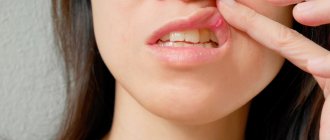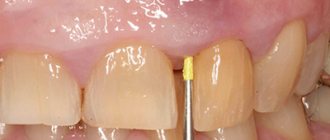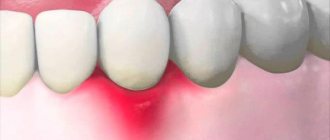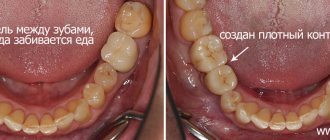Diastema is an empty space between teeth, ranging in size from one to five to six millimeters. A characteristic gap forms between the front incisors. Moreover, in some its appearance is due to heredity, in others - anomalies in the structure of the dental system.
The reason may be incorrect position of the teeth, pathologies in the structure of the frenulum, partial edentia, for example, the absence of lateral incisors or microdentia - the small size of dental crowns. Sometimes diastema is provoked by bad habits - biting pencils, pens and nails, as well as sucking a pacifier for a long time in childhood.
What is the correct name for the gap between the front teeth?
What we call a gap, in the language of dentists, sounds like a diastema (diastema - translated from Greek - interval, distance).
To one degree or another, diastema occurs in almost every fifth adult on the planet, and in every second child with baby teeth. Diastema is an abnormally large gap between the central upper or lower incisors of the dentition. Its dimensions can vary from 1 to 10 mm. But most often there are clefts ranging from 2 to 6 mm. Do not confuse a diastema with a trema, which forms anywhere in the dentition, excluding the central incisors.
Important! The gap between the front teeth in adults and children requires a preventive examination by a dentist. If the pathological process increases, a specialist may recommend removing the gap.
Important! During a dental examination, a specialist examines and classifies the diastema. Based on the complexity of the problem, the patient will be offered the most effective method of eliminating it.
All problems can be solved
An even dentition, white teeth of regular shape adorn any person and serve as an integral part of an ideal smile. Thanks to this, everyone can feel attractive, because in the modern world almost any dental defect can be successfully corrected. Thanks to this, many patients are able to return to normal life. Therefore, if you are concerned about the presence of a diastema, this imperfection can be corrected quite quickly and painlessly in dentistry near the Krasnye Vorota, Baumanskaya, Novokuznetskaya and Tretyakovskaya metro stations. Do not be indifferent to your health and psychological state, and confidently contact dental specialists to solve your problems.
Types of diastemas
When faced with the problem of a gap between the front teeth, one should distinguish between false and true diastema.
- False – occurs in children with baby teeth. After they change and as the bite forms, it can go away on its own.
- True - diastema formed after the replacement of baby teeth and the formation of a bite, i.e. in adulthood. On its own, a visible gap between the teeth of an adult will not go away and needs treatment.
According to its structure, the cleft can be of two types.
- Symmetrical - a phenomenon in which the incisors change their location symmetrically with respect to each other and the conditional center of the dentition.
- Asymmetrical – a defect in which one of the front teeth retains its natural position, while the second deviates to the side, thereby forming a gap.
And taking into account the direction of the vertical axis of the anterior incisors, the classification of diastemas will be as follows.
- Lateral deviation of the crowns, in which the roots are parallel, and the incisors themselves diverge from each other, forming a gap.
- Body lateral displacement - the front teeth change their location along with the root.
- The medial inclination of the central incisor crowns is the most complex type of diastrema, in which the roots and teeth are subject to displacement. Incisors can grow to the side or rotate around their axis.
Ways to correct gaps between teeth
Diastema correction is a jewelry process whose main goal is to achieve the most even and perfect alignment of the central incisors. Depending on the complexity of the problem and the age of the patient, it may take 1 – 2 procedures or last for several years. The following methods of correcting the defect are recognized as the most effective and popular.
1. Braces
To close the gap, the patient may be offered to wear braces - a non-removable orthodontic structure that allows you to straighten the dentition and give the correct position to the incisors. It is attached to the outside or inside of the teeth and can be completely invisible. Braces show the greatest effectiveness at the age of 16 years, while the bone tissue of the jaw is not yet fully formed. Wearing braces for adult patients is often unjustified, since after the orthodontic system is removed, the incisors may gradually return to their original position and form a gap again. The average cost of treatment is 50,000 rubles (prices are current for 2018).
Advantages of braces systems
- Safely.
- Effective.
Flaws
- Duration of wearing can reach 3 years.
- More careful and thorough oral care is needed.
- Do not remove until the end of treatment.
2. Records
A removable orthopedic structure, the operating principle of which is similar to braces. The plate, equipped with “hand-shaped processes,” pushes the problematic incisors in the right direction and gradually they take the correct position. It is most advisable to use plastic surgery at an early age - up to 12 years, while the bone tissue of the jaw and the position of the teeth are well amenable to correction. The average cost of treatment is 30,000 rubles (prices are current for 2022).
Advantages
- Safely.
- Effective.
- You can shoot.
Flaws
- Suitable only for correcting minor defects.
3. Mouth guards
Removable aligners are orthodontic structures that are a kind of “covers” that are put on the teeth. Manufactured using 3D technology, they apply the necessary pressure to problematic incisors, thereby moving them in the desired direction. By successively replacing the mouth guards in size, from larger to smaller, the gap is eliminated. The average cost is 150,000 rubles (prices are current for 2022).
Advantages
- Safely.
- Effective.
- You can shoot.
- Transparent aligners are invisible on the teeth.
Flaws
- Cost of treatment.
4. Veneers
Veneers are microprostheses that act as a kind of facing material for the outer surface of problem teeth. Their installation allows you to close the gap, in the literal sense of the word. Made from modern, reliable materials, they do not cause allergies and are completely invisible on the dentition. The average cost of closing a diastema is 30,000 rubles (prices are current for 2022).
Advantages
- Safely.
- Effective.
- Large selection of materials and colors of veneers.
- Quick visible results.
Flaws
- Pre-grinding of the incisors is required.
- After about 10 years, the veneer will wear out and will need to be replaced.
- There are contraindications - bruxism, increased tooth wear. An extreme lifestyle is also a limitation.
5. Lumineers
Lumineers are an orthopedic overlay, somewhat similar to veneers. Like them, lumineers are installed on the outer surface of the central incisors and completely cover the diastema. In terms of aesthetics, they are superior to veneers and allow you to get a sparkling Hollywood smile. The average cost of installation is 30,000 rubles (prices are current for 2022).
Advantages
- Safely.
- Effective.
- Quick visible results.
- No pre-grinding is required.
- Average service life is 20 years.
Flaws
- There are contraindications - bruxism, increased tooth wear, extreme lifestyle.
6. Crowns
Crowns are permanent orthopedic structures that completely cover the incisor, allowing the gap to be closed. They can be made of plastic, ceramics, metal or combined materials. The average cost of 1 crown is 20,000 rubles (prices are current for 2022).
Advantages
- Safely.
- Effective.
- Large selection of materials.
- Quick visible results.
- Invisible on the dentition.
- Can be installed on damaged teeth (up to 60% destruction is allowed).
- Average service life is 10 – 20 years.
Flaws
- Pre-grinding of the tooth is required.
7. Implants
Implants are non-removable orthopedic structures designed to replace missing teeth that have caused the formation of a diastema. An implant embedded in the osseous tissue of the jaw replaces the roots of the tooth, allowing you to completely restore the functionality and aesthetics of the crown of the problematic incisor. The average cost of prosthetics is 40,000 rubles (prices are current for 2018).
Advantages
- Safely.
- Effective.
- Large selection of materials.
- Quick visible results.
- Lifetime service life.
Flaws
- Postoperative observation is required.
- There are contraindications.
8. Cosmetic correction
This method is effective for minor diastemas. In this case, the dentist simply places a small filling in the space between the incisors, thereby visually eliminating the problem. The average cost of closing a diastema is 3,000 rubles (prices are current for 2018).
Advantages
- Safely.
- Effective.
- Quick visible results.
- No contraindications.
Flaws
- Over time, the filling may change its color, disrupting the aesthetics of the dentition.
- Average service life is 5 – 7 years.
- It is necessary to control (reduce) the load on the front teeth at the moment of biting.
- Risk of developing caries at the junction of the incisors.
9. Artistic restoration
Unlike cosmetic correction, artistic restoration is more durable. During the restoration process, the dentist builds up the tissue of the front teeth using layer-by-layer application of composite materials. Hardening under the influence of an ultraviolet lamp, they look natural, like part of a tooth, and create the effect of a tight closure of the incisors. The average cost of such aesthetic camouflage of a defect is 12,000 rubles (prices are current for 2022).
Advantages
- Safely.
- Effective.
- Quick visible effect.
- The buildup is invisible on the surface of the tooth.
- No contraindications.
Flaws
- It is necessary to control (reduce) the load on the front teeth at the moment of biting.
10. Surgical plastic surgery
Surgery is necessary when the diastema is formed due to improper position of the labial frenulum. A low-attached frenulum simply will not allow the incisors to close, and they will form a gap. To eliminate a congenital defect, specialists perform frenuloplasty - the distance between the front teeth is reduced naturally and they take the correct position. After plastic surgery, you may need to wear orthodontic appliances. The average cost of the operation is 7,000 rubles (prices are current for 2022).
Advantages
- Safely.
- Painless.
- Effective.
Flaws
- The duration of elimination of diastema may take several years.
advantages
Important! The sooner the incorrect location of the frenulum is detected, the easier it is to correct the defect. The ideal age for this is 5–8 years. The frenuloplasty performed during this period promotes independent closure of the incisors, without wearing orthopedic structures. At an older age, and even more so in adult patients, the teeth will need help - the incisors must be guided and brought together using braces, plates or aligners.
Use of artistic restoration
Some patients are advised to undergo aesthetic artistic dental restoration to eliminate diastema. This is a therapeutic intervention during which composite microprostheses (veneers) are installed on the two central incisors, between which there is a gap. The doctor uses a filling material that matches the patient’s natural enamel shade and builds up additional volume of hard tissue on the two central front teeth. To undergo this procedure, you only need to visit the clinic once.
When restoring a tooth, the doctor restores its shape and function. The presence of colored deposits and cracks in the enamel, and other signs of destruction of dental tissue does not play any role, since most of the visible dental tissue is removed. Then its natural shape, color and functional properties are formed using composite materials (build-up method). If the root of a tooth is damaged, it is treated first, and restoration is carried out only at the next stage. If no pathologies associated with the tooth root are detected, then in 5-6 hours a qualified doctor is able to restore at least 4-5 teeth. However, if the dentist first works with the root of the tooth, then further manipulations are carried out after at least two days.
An important advantage of artistic restoration is its complete painlessness. Another important advantage of this method is its safety, therefore it has a minimal list of contraindications. Dental restoration can be performed on women even during pregnancy.
Cost of treatment in our clinic
The cost of eliminating the gap between the front teeth is determined based on the following factors.
- Complexity of the problem.
- Elimination method.
- Cost of consumables and medications.
In this table you can see the approximate prices of various methods of correcting a defect.
| Remedy | Prices |
| Braces | From 16,000 rubles |
| Records | From 20,000 rubles |
| Mouth guards | From 130,000 rubles |
| Surgical plastic surgery | From 5000 rubles |
| Veneers | From 20,000 rubles |
| Lumineers | From 20,000 rubles |
| Crowns | From 18,000 rubles |
| Implants | From 30,000 rubles |
| Cosmetic correction | From 2000 rubles |
| Artistic restoration | From 10,000 rubles |
Is it possible to remove a hole between teeth at home?
No! You cannot get rid of the gap between your front teeth on your own, with the help of folk remedies, spells and other “miraculous” techniques. The exception is false diastema, which disappears on its own as the child grows older.
Important! You should not tie the front teeth with a tight thread, trying to force them closer to each other. In childhood, this will cause improper formation of the jaw and unnatural position of the teeth. In adult patients, this leads to loose teeth. In patients of all age groups, this method of eliminating diastema can lead to the development of caries and periodontitis.
Important! If you encounter one or more causes of a gap, you should immediately consult a dentist.
Is chipping a feature or a pathology?
Diastema can be considered a “highlight” if a person’s dentition is symmetrical and there are no malocclusions. The time has passed when ideal beauty was valued; nowadays, getting closer to the ideal has become quite simple. Now you need to be a person, to have individual characteristics that distinguish you from others. The perfectly straight, snow-white teeth of models that adorn the cover of every second glossy magazine no longer impress anyone. Shcherbinka in these conditions is used as a way to distinguish yourself and be remembered.
What do dentists think about this? Experts consider diastema as an aesthetic and functional defect of the dental system. As a rule, the gap between the incisors is combined with other malocclusions. Also, due to the incorrect relationship of antagonist teeth in the anterior section, secondary changes develop:
- the risk of developing caries and inflammatory processes in gum tissue increases;
- The gap does not always contribute to clarity of speech and correct pronunciation of all sounds.
And since the gap is regarded as a defect, dentists advise getting rid of it.
Why does a gap appear between the front teeth?
The formation of diastema is influenced by a number of negative internal and external factors. The most likely reasons for the appearance of a gap are:
- Genetic (hereditary) predisposition.
- Too pronounced interdental papillae.
- Incorrect position of the lip frenulum.
- Late change of primary teeth.
- Slow growth and formation of central incisors.
- Partial or complete absence of teeth as a result of abnormal formation of the dental system.
- Pathological arrangement of teeth.
- Gum pathologies.
- Presence of supernumerary teeth.
- Microdentia – the patient’s teeth are small in size.
- Bad habits – chewing, sucking, etc.
- Injuries to the front teeth.
How to prevent a gap in a child?
Caring parents should adopt a few simple rules that will help avoid the formation of diastema.
- Regular examination by the dentist, which is especially important if the child is genetically predisposed to the appearance of a gap - every 6 months.
- Strict adherence to the rules of oral hygiene.
- Providing adequate nutrition for the child with foods high in calcium, magnesium, fluorine, phosphorus, vitamins D, C, A.
- Try to stop your child’s bad habits - sucking objects, fingers, chewing pencils, seeds, nuts, etc. with his front teeth.
Important! An earlier visit to the dentist allows you to avoid the final formation of a diastema and will help eliminate any defects in the dentition.
Conclusions. Expert advice
A gap or gap between the front teeth is called a diastema. This is a malocclusion that occurs for various reasons: genetics, early change of teeth, anomaly in the shape or size of the incisors, etc. There are false and true diastemas: the first appears in children and is “outgrown”, the second is permanent and requires treatment.
It is possible to get rid of the gap between teeth, but all methods require a visit to the orthodontist, and attempts to correct the problem using traditional methods are simply dangerous. To correct the dentition, braces, plates, mouth guards, and surgical methods are used. You can also make cosmetic corrections: install veneers and lumineers, close the gap with a filling, or extend incisors.
It is not necessary to correct the diastema if it is small and the doctor considers it safe. A small cleft is a cosmetic defect. If the gap is large, it causes caries, eating problems, curvature of the jaw bone, etc. The development of diastema can only be prevented through regular visits to the doctor.
Consequences
Whether to correct a diastema or not is a personal matter for each patient. But it is necessary to understand that its existence may have a number of undesirable consequences and complications.
- Violation of the aesthetics of the dentition.
- Formation of malocclusion.
- Impaired diction.
- Development of caries and periodontitis.
Not to mention the fact that a gaping gap between the front teeth can cause psycho-emotional experiences for its owner and cause the formation of serious complexes.
Important! Over time, even a minor diastema can increase in size, which will require its correction and treatment.
Read also
How to place veneers
The installation of veneers is performed for the purpose of aesthetic restoration of the dentition.
How long do you wear braces and what affects the timing?
When deciding on the use of orthodontic structures, patients are often interested in how long they wear braces on their teeth.









